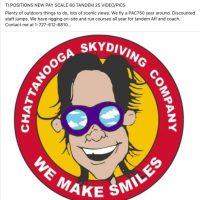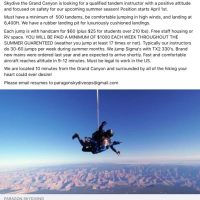
“If I had more instructors, we could be doing so much more business.”
This, the lament of nearly every DZO since the summer of 2019.
No longer are DZs competing on the lowest-priced tandem; it’s now who can pay the highest rate to a TI to lure them to your DZ. The benefit of this shift of lower supply (capacity) and higher demand is resulting in price points the industry has been needing to see for 20 years. Tandem rates between $235 and $300 are much more commonplace, but it doesn’t solve the core issue of staffing which, if this trend continues, will lead to a new set of staffing challenges.
Let’s speculate on a theoretical scenario:
If the pandemic continues to stifle travel (the reason I believe skydiving is surging right now) and staffing supply continues to dwindle, then it’s likely that a continued domino effect will occur in succession:
1. Tandem prices will continue to increase in order to attract staff and capitalize on maximizing revenue, flying fewer loads. We’re seeing this trend showing up in Skydive Jobs highlighting that tandem instructors can now make between $85 and $100 per jump including handcam.
2. Demand will stabilize once the price of a tandem matches what the market can bear. Thus far, I have clients who have elevated their prices between $20 and $50 and have barely seen a reduction in demand. It’s likely we’ll see prices move north of $300 in some markets.
3. Higher pricing will result in lower volume of student jumps because skydiving will become less affordable for many.
4. Lower student volume will equate to a smaller percentage of new skydivers which will see a further reduction of new instructors and riggers.
5. The pandemic ends. People return to traveling (and the return will be very strong). As a result, demand for skydiving begins to decrease. To maintain demand and keep instructors jumping, the cycle repeats in the opposite way; prices begin to drop, but the pay rate for instructors will not (who wants to tell their staff they have to pay them less?). This results in a reduction in profit margin which will need to be made up by increasing volume.
I’m not an economist and of course, the scenario I’ve painted may not become a reality as there are 101 variables that could shift the economy in a different direction creating new and unseen challenges, but I feel confident that the current hot market for skydiving will eventually cool. Our industry needs to be careful not to elevate our pricing too much in response to the current market conditions because we could further worsen the staffing shortage and eventually erode our profit margins if we get too aggressive now.
Peloton’s Drop
In the past week, Peleton announced it will stop the manufacturing of its products during the month of February, and significant layoffs are likely to follow. During the height of the pandemic, Peloton could not keep up with demand and scaled dramatically to try and meet it (an overcorrection). Since that time, more people have returned to gyms leaving the demand for Peloton a fraction of what it once was.
Manufacturing has to be slowed as the supply (inventory) of their products is surging. It’s likely that the $2,000 price tag for an exercise bike will need to be discounted to move the excess inventory or other creative incentives be created.
This comparison to the skydiving industry is not apples to apples (we don’t sell products, nor can we meet the current demand), but it’s likely that the current surge in demand we’re experiencing won’t continue forever. The decisions we make today related to how much we adjust our prices needs to take what happens next into consideration.

So what’s the takeaway here?
Balance. To capitalize on the current market trend and be positioned when the market cools, DZs should gradually increase rates but also gradually increase supply by having more instructors which leads us back to the core issue:
How Do We Increase Our Supply of Instructors?
Before we can solve a problem, we have to identify the friction points that led to where we are and identify which amongst them can be solved or improved.
Some of our challenges are as follows:
- Most skydives in the US can’t be made until age 18
- Many first jumps are one and done
- Progress through AFF is slow, arduous, and expensive
- Mentorship between AFF and A license is often lacking causing low retention
- Mentorship, post-A-license, is often lacking causing low retention
- It’s expensive to learn to skydive
- Making a career as a skydiver is challenging
I don’t have all the answers, but I do think that if we can improve the challenges our industry faces at the individual DZ level, the cumulative effect will be impactful. Building this awareness will need to start at the top with skydiving associations and be embraced by DZOs. To me, the biggest nut to crack is exposing young people to skydiving before the age of 18.
Planting the Seed Earlier
This may sound crazy because it’s different than what we’re accustomed to, but I believe there needs to be a strong push for every DZ to actively reach out to elementary, middle, and high schools to offer a field trip opportunity. Teachers (particularly science teachers) would eat this up.
Showing kids all the inner workings of a parachute and teaching the science behind terminal velocity, spotting, and doing a demo at the DZ with a Cessna load of staff would go a long way for the sport if done at scale. The initiative would need to be highlighted by each country’s skydiving association just as SIS events were created in the US to promote women’s inclusivity and retention in the sport.

Exposing kids to skydiving at an early age is an investment in our future which will result in more tandems being made, creating licensed skydivers, and of course instructors.
A pre-requisite exists for this initiative: The US Army Golden Knights and the Red Devils in the UK. I have met many skydivers who said they saw the Golden Knights perform at an event that inspired them.
We need to plant the seed earlier and I think this is the way to do it.
One and Done to One and Two?
Skydiving isn’t for everyone and the majority of our clientele will make only one jump, but what if we could improve the return rate by 1%?
1% of 100,000 tandem skydives is 1,000 additional people coming back. Of course, there are way more than 100,000 people making tandems annually and many people do return, but increasing that return rate by 1% is substantial.
The more tandems we can get students to make, the higher the probability of getting them to register for a first jump course.
Additionally, most DZs do a poor job of getting tandem students to opt in to receive messages after their jumps which is short sighted as these folks have tasted the skydiving drug; we need to be their adrenaline dealers by offering them opportunities to do it again. And for those that say e-mail marketing is dead… I’ve got lots of data that says otherwise when e-mail marketing is executed well. You’re likely reading this because of our e-mail marketing!
AFF Progression
When it comes to progressing students through AFF, we are our own worst enemies. Having visited multiple dozens of DZs, I see the same pattern unfold at many places: students waiting and waiting and waiting because of our own inefficiency usually caused by poor scheduling and communication with both staff and students.
No one likes to wait especially Gen Z’ers. We cannot expect students to leave their social groups on the weekend, be out of their comfort zones at a location an hour from home and have them make one jump in a day while charging a premium price for the privilege. If we ourselves experienced this elsewhere, we’d be frustrated and leave just as many of our AFF students are doing.
If we are going to see improved graduation rates in AFF, we have to ensure that when a student arrives, they are in motion; our goal should be to get these students jumping more in tighter pockets of time because as we all know, the more we can get people in the air with greater frequency, the greater the likelihood they’ll stick with it.

Improved Mentorship
Every DZ has its own set of limitations, but this is a problem that needs to be addressed and it likely needs to involve fun jumpers: a mentorship program. Just as a college student is assigned an advisor, a mentor needs to be assigned to someone who encourages and actively invites students to come down to the DZ and ensure they feel part of the community.
Students feel uncomfortable enough learning to skydive, we need to make sure they’re not feeling that way while also on the ground. Having someone to help bridge the gap, make them feel welcome, and encourage them would go a long way with retention.
It’s Expensive
It’s expensive, and I’m not about to suggest that DZs offer a discount (we’ve done enough of that), but I often think about having printed materials that highlight opportunities to earn our way through training via packing, editing, checking in students or cleaning bathrooms and planes. Not everyone will admit that they can’t continue because of finances and so we need to be clear that the dream can continue.
Making a Career Out of Skydiving
Aside from the lack of benefits, long hours, no retirement plan, and job risk, it’s easy to see why instructors don’t stand the test of time. Many who do stick around tend to be a little crispy in the joy department. Our industry needs to start thinking about how to retain our instructors for longer by making this job more sustainable. We could also gain by creating a progression program that allows for growth beyond the position of instructor. We all know how hard it is to find a good DZM!
(Speaking of, if you’re interested in becoming a DZM or are one and would like to find a position elsewhere, please e-mail me).
CLOSING THOUGHTS
I don’t wish to simplify the challenges of our industry or pretend to have it all figured out (I don’t), but I do know this: we have to think differently about growing our sport. Just as we jump from 10,000′ we need to look at our individual businesses and the industry at large from the same perspective.

General
Skydiving PR: From Local to Global News

General
Managing the Media During a Crisis

General
RESCUE GONE WRONG

General
Solving the staffing crisis in skydiving










